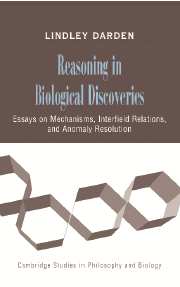 Reasoning in Biological Discoveries
Reasoning in Biological Discoveries Book contents
- Frontmatter
- Contents
- Long Contents
- List of Figures
- List of Tables
- Acknowledgments
- Introduction
- PART I BIOLOGICAL MECHANISMS
- 1 Thinking About Mechanisms with Peter Machamer and Carl F. Craver
- 2 Discovering Mechanisms in Neurobiology: The Case of Spatial Memory with Carl F. Craver
- 3 Strategies in the Interfield Discovery of the Mechanism of Protein Synthesis with Carl F. Craver
- 4 Relations Among Fields: Mendelian, Cytological, and Molecular Mechanisms
- PART II REASONING STRATEGIES: RELATING FIELDS, RESOLVING ANOMALIES
- PART III DISCOVERING MECHANISMS: CONSTRUCTION, EVALUATION, REVISION
- Bibliography
- Index
- References
4 - Relations Among Fields: Mendelian, Cytological, and Molecular Mechanisms
Published online by Cambridge University Press: 31 August 2009
- Frontmatter
- Contents
- Long Contents
- List of Figures
- List of Tables
- Acknowledgments
- Introduction
- PART I BIOLOGICAL MECHANISMS
- 1 Thinking About Mechanisms with Peter Machamer and Carl F. Craver
- 2 Discovering Mechanisms in Neurobiology: The Case of Spatial Memory with Carl F. Craver
- 3 Strategies in the Interfield Discovery of the Mechanism of Protein Synthesis with Carl F. Craver
- 4 Relations Among Fields: Mendelian, Cytological, and Molecular Mechanisms
- PART II REASONING STRATEGIES: RELATING FIELDS, RESOLVING ANOMALIES
- PART III DISCOVERING MECHANISMS: CONSTRUCTION, EVALUATION, REVISION
- Bibliography
- Index
- References
Summary
INTRODUCTION
Philosophers of biology have debated the nature of the relations between Mendelian genetics and molecular biology for some fifty years. They have proposed a variety of relations between the fields, including reduction, replacement, and explanatory extension. This chapter proposes a new analysis: the two fields discovered separate but serially connected mechanisms. These hereditary mechanisms have different working entities and the mechanisms operate at different times in an integrated temporal series of hereditary mechanisms. This analysis better characterizes the practice of biologists than previous accounts, as evidenced both by the historical development of the two fields and by presentations of the results of the two fields in contemporary textbooks.
Accounts of formal reduction played many roles in philosophical analyses of science in the second half of the twentieth century. Reduction was seen both as the relation among theories at different levels of organization at a given time (sometimes called “microreduction”) and as the relation between predecessor and successor theories. Furthermore, reduction was tied closely to explanation. The connection between what was to be explained (the explanandum) and what did the explaining (the explanans, usually general laws) was claimed to be (usually) deduction (Hempel 1965). Hence, the deduction of the reduced theory (or the observations that it explained) from the reducing theory in formal reduction permitted the claim that the reducing theory explained the reduced theory (or its observation statements). The status of the reduced theory after a reduction was different in different accounts of formal reduction.
- Type
- Chapter
- Information
- Reasoning in Biological DiscoveriesEssays on Mechanisms, Interfield Relations, and Anomaly Resolution, pp. 98 - 124Publisher: Cambridge University PressPrint publication year: 2006


